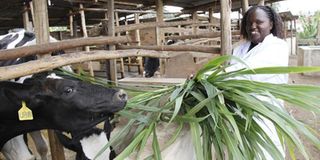Feeding cows for good body condition and high milk production

Sarah Mwangi feeds her dairy cows in Ngong, Nairobi. FILE PHOTO | JEFF ANGOTE | NATION MEDIA GROUP
What you need to know:
- Feeding less nutrients can result in weak animals prone to diseases with poor body condition, low milk production and reproduction problems.
- Feeds should contain dry matter (DM) which is portion remaining after all water is removed from feeds.
- Dry forages are a good source of crude fibre.
- At feeding mix treated crop residues with molasses for improved palatability.
A balanced diet for dairy cows should contain the right amount of nutrients. Feeding too much is uneconomical and can impact cows’ health.
Feeding less nutrients can result in weak animals prone to diseases with poor body condition, low milk production and reproduction problems.
Carbohydrates and fats supply energy, proteins build up strong muscles, minerals and vitamins are useful for strengthening bones and efficient body functioning.
These nutrients are all available in plants with proportion varying with the part of the plant used for feeding cows.
Feeds should contain dry matter (DM) which is portion remaining after all water is removed from feeds.
It contains all nutrients and is used to determine quantity of nutrients provided dairy cows. Feed intake (on DM basis) for maintenance of dairy cows can be estimated at three per cent of bodyweight.
Therefore a cow weighing 350 kg will need (350/100)*3= 10.5 kg of DM feeds. To allow for milk production we can use this formula: 6kg + (body weight/100) + (milk yield/5).
A cow weighing 350 kg producing 15kg milk/ day will need 6kg + (350/100) + (15/5)= 12.5 kg DM feeds. From this quantity an allowance for at least 15% crude protein and 20% crude fibre should be provided.
Dry forages are a good source of crude fibre. Cows should have free access to water. If not available consider 4-6 L water per kg DM feeds.
Commonly used feed resources include:
Forages used as basal feeds are generally high in fibre and constitute bulk of feeds.
Green forages: pastures, Napier, maize forage, sorghum forage (DM = 20-25%)
Dry forages: cereal residues (DM= 80-90%)
Silage (DM=17-20%),
Treated crop residues (DM=42-50%)
Forages used as supplementary feeds:
Green forages: lucerne, desmodium, caliandra, leucaena, etc. (DM=20-25%)
Dry forages: legumes and cereal residues (peas, beans, maize stalks, etc.) (DM=80-90%)
Harvesting forages
Napier grass: 1 meter high (height of panga) (3-4 months)
Lucerne: when it begins to flower, cut at 5cm from the ground every 5-7 weeks
Maize and sorghum forage: at early bloom
Forage preservation and value addition
Silage preserves nutritive value and increase forage production with limited available land. It can therefore be made in rainy season when forages are plenty in preparation of dry season when forages are scarce.
Use 10 kg wilted Napier grass (or lucerne, maize, sorghum) chopped and mixed with 1 kg molasses in 3 L water and keep for 21 days in airtight sealed silage tube.
Urea treatment of cereal crop residues will improve on their digestibility and nutritive value.
Use 400g urea in 5 L water sprinkled on 10 kg chopped maize stovers (or wheat straws, or other cereal crop residues) and keep for 21 days incubation in airtight sealed silage tube.
At feeding mix treated crop residues with molasses for improved palatability. Yeast cultures can also be added.
***
Olivier Kashongwe B. Department of Animal Sciences, Egerton University




